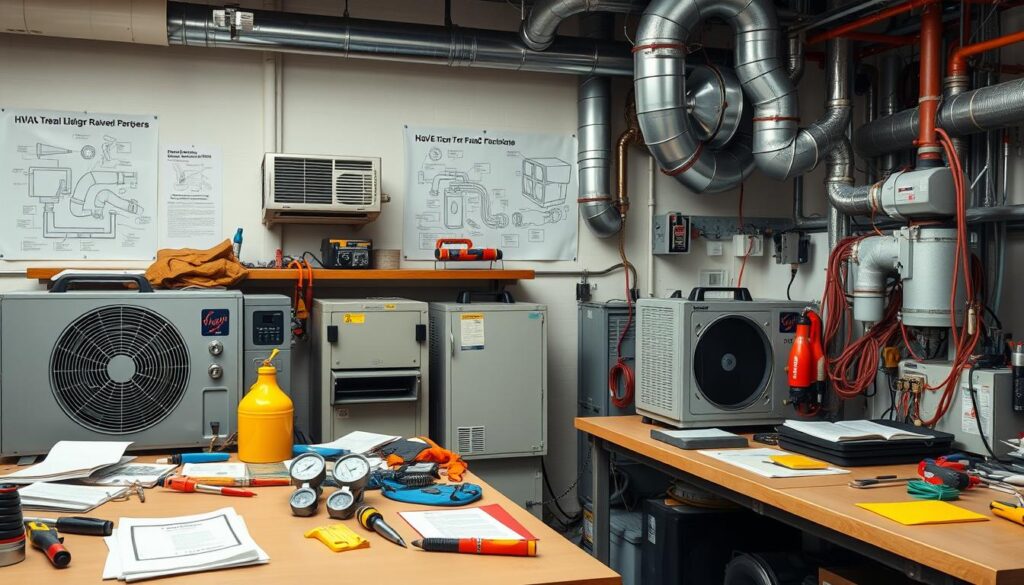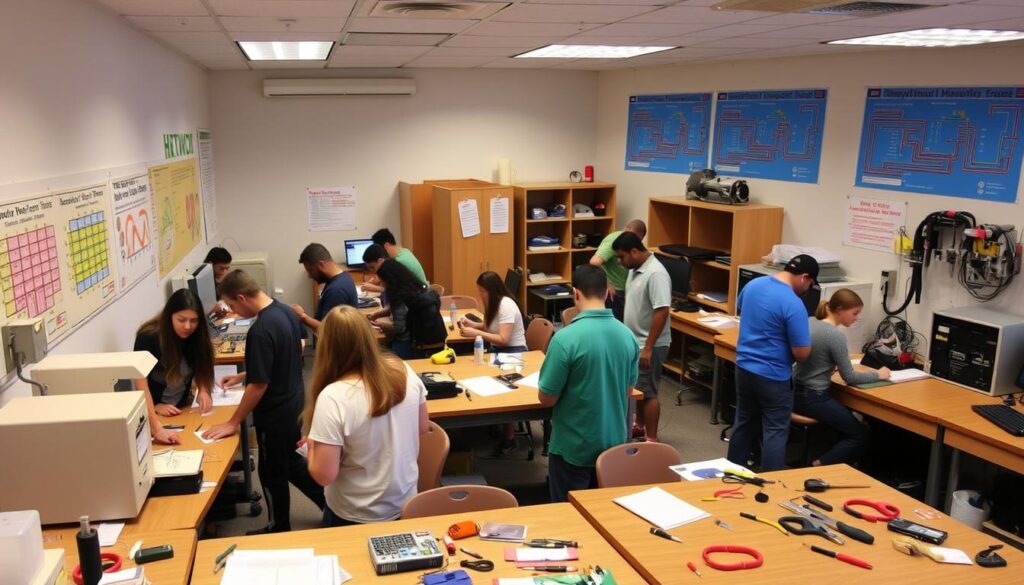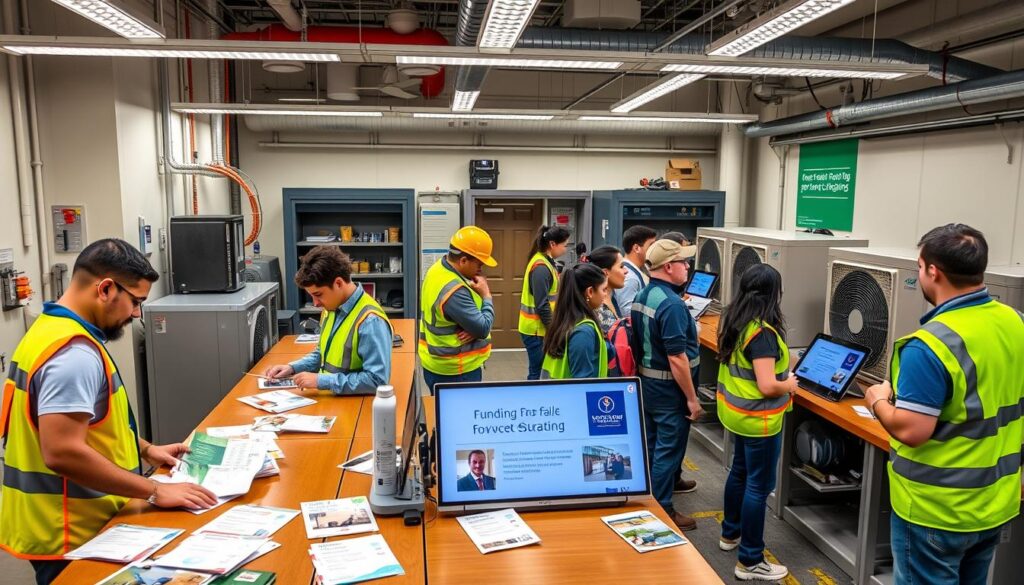Affiliate Disclosure
HVAC Guide Guys is a participant in the Amazon Services LLC Associates Program, an affiliate advertising program designed to provide a means for sites to earn advertising fees by advertising and linking to Amazon.
Thinking about how to pay for HVAC school can be tough. But, there’s good news. Financial aid can help a lot. Even though college costs keep going up, there are ways to get help.

Key Takeaways
- FAFSA can cover the cost of HVAC training programs, including tuition, books, and materials.
- HVAC schools often offer flexible payment plans to ease the financial burden.
- Federal grants, scholarships, and student loans can significantly reduce out-of-pocket expenses.
- Navigating the financial aid process can be complex, but HVAC school advisors are available to provide guidance.
- Exploring industry-specific scholarships and grants can unlock additional funding opportunities.
Table of Contents
Understanding HVAC School Costs and Financial Aid Options
Starting an hvac certification programs or hvac vocational school journey can be exciting. Yet, the initial costs might seem high. But, the price of hvac trade school tuition is often lower than a four-year college degree.
Average Program Costs
HVAC training costs vary a lot. They can start at $1,200 for brief programs and go up to $20,000 for apprenticeships. Community college HVAC programs usually cost about $3,440 a year for in-state students. These programs last 18 months to 2 years.
Apprenticeships, which mix work experience with classroom learning, cost between $15,000 and $20,000.
Comparison to Traditional College Expenses
At a public community college, students pay around $4,864 a year for in-state tuition. Out-of-state students pay about $8,622 annually. Private colleges charge about $15,100 for two years.
Textbooks, supplies, and living costs add to the total cost of college.
Payment Plan Availability
Many schools offer flexible payment plans to help with costs. These plans let you pay tuition over time. There are also government grants, student loans, and vocational scholarships to help with expenses.
Looking into financing options and using payment plans can make HVAC school costs more affordable. This opens the door to a fulfilling HVAC career.
Explore Our HVAC Shop
Looking for top-rated HVAC tools, parts, and accessories? Visit our shop and find the perfect solution for your needs.
Visit the ShopDoes FAFSA Cover HVAC School: Everything You Need to Know
Getting an HVAC education is a smart move for your future. The bright side? FAFSA, the Free Application for Federal Student Aid, might cover some of your HVAC degree or training program costs. If you’re eyeing a certificate, diploma, or associate degree, knowing how FAFSA works is crucial. It helps you get financial aid for your HVAC technician education expenses.
To start, go to studentaid.gov and fill out the FAFSA form online. This way, you avoid mistakes and get your aid faster than paper applications. Your school’s financial aid office can give you a paper form if you need it. You might also have to send extra documents like tax returns or proof of income to see if you qualify for FAFSA for HVAC programs.
“FAFSA can open the door to a wide range of financial aid opportunities for HVAC students, from grants and scholarships to federal student loans.”
Don’t let the cost of HVAC degree programs stop you from reaching your career dreams. With FAFSA, you might get the funding you need to make your HVAC education cheaper. By looking into all your options, you’re on your way to a fulfilling career in the HVAC industry.
Explore Our HVAC Shop
Looking for top-rated HVAC tools, parts, and accessories? Visit our shop and find the perfect solution for your needs.
Visit the ShopTypes of Federal Financial Aid for HVAC Training
Starting a career in HVAC (Heating, Ventilation, and Air Conditioning) is rewarding. There are many federal financial aid options to help you. You can get grants, loans, and benefits for veterans. These make your HVAC hvac career training funding easier to get.
Government-Funded Grants
Government-funded grants are a great choice for HVAC training. Awards like the Pell Grant don’t need to be paid back. You need to show financial need to get them. This is done by filling out the Free Application for Federal Student Aid (FAFSA).
Federal Student Loans
There are also federal student loans for hvac school financial aid. Loans like Direct Subsidized and Unsubsidized Loans need to be paid back. But, they have good interest rates and flexible payment plans.
Veterans Benefits and GI Bill
For military veterans and their families, the GI Bill is a big help. It gives tuition aid, housing help, and more. It’s from the U.S. Department of Veterans Affairs to support your education.
Looking into these federal aid options is a big step. It helps you reach your HVAC career goals without breaking the bank.
Applying for HVAC School Financial Aid Through FAFSA
Getting financial aid for HVAC training can seem tough. But, the Free Application for Federal Student Aid (FAFSA) can help a lot. It opens doors to federal grants, loans, and more, making your HVAC education cheaper.
To start, just go to studentaid.gov and fill out the FAFSA online. This way, your info is accurate and processed quickly. After you submit it, you’ll get your Student Aid Report (SAR) fast. This lets you plan your HVAC training with more confidence.
If you’d rather use a paper form, talk to your HVAC school’s financial aid office. They can help you fill it out right.
“The majority of students at Midwest Technical Institute receive some form of financial aid.”
Remember, the FAFSA is your ticket to many funding options for HVAC school. By filling it out, you’re moving closer to your HVAC career dreams.
| Funding Source | Description | Award Amount |
|---|---|---|
| Federal Pell Grant | Need-based grant for undergraduate students | Up to $6,895 per year (2023-2024) |
| Federal Direct Subsidized Loan | Need-based loan for undergraduate students | Up to $3,500 – $5,500 per year |
| Federal Direct Unsubsidized Loan | Non-need-based loan for undergraduate and graduate students | Up to $5,500 – $12,500 per year |
By filling out the fafsa for hvac programs, you’re on your way to getting the hvac school financial aid you need.
HVAC-Specific Scholarships and Grants
Getting into the HVAC field doesn’t have to cost a lot. There are many scholarships and grants for those interested in hvac certification programs and hvac career training funding. These can make HVAC education more affordable. They help students get the training needed for a successful HVAC career.
Industry-Sponsored Programs
Many HVAC companies and groups give out scholarships. For instance, the EGIA Foundation HVAC Hero Scholarship gives $2,500 to 30 students each year. The ASHRAE Society Scholarship offers up to $10,000 for engineering students studying HVAC-R.
Merit-Based Opportunities
There are HVAC scholarships based on grades, leadership, and more. The Rees Scholarship Foundation covers tuition for a semester or two in HVAC-R and water heating. The Trade Academy HVAC Scholarship, with Housecall Pro, gives 40 $2,500 scholarships to future HVAC pros.
Professional Organization Awards
Groups like the Plumbing-Heating-Cooling Contractors (PHCC) Educational Foundation offer scholarships from $1,500 to $10,000. The NAWIC Founders’ Scholarship Foundation gives over $100,000 yearly for construction fields, including HVAC.
With some research, students can find many scholarships and grants for HVAC training. These can help fund their education and start a fulfilling HVAC career.
Explore Our HVAC Shop
Looking for top-rated HVAC tools, parts, and accessories? Visit our shop and find the perfect solution for your needs.
Visit the ShopSteps to Secure Financial Aid for HVAC Training
Choosing a career in HVAC (Heating, Ventilation, and Air Conditioning) is a smart move. It offers good job prospects and decent pay. But, the cost of training can be high. Luckily, there are ways to get financial help and make your education more affordable.
- Research HVAC Schools and Programs: First, look for HVAC schools and programs near you. Compare their costs, what they teach, and how to get in. This will help you find the right school for your budget and goals.
- Complete the FAFSA: The Free Application for Federal Student Aid (FAFSA) is key to getting financial aid. It helps you get grants, loans, and work-study programs. Fill it out early to increase your chances of getting help.
- Explore Scholarships and Grants: Look for HVAC scholarships and grants from industry groups, professional associations, or schools. These can help cover tuition, books, and other costs.
- Inquire About Payment Plans: Many HVAC schools have payment plans or financing options. Talk to the financial aid office to see what’s available.
- Consider Employer Sponsorship: Some HVAC employers offer to pay for your training. Contact potential employers to see if they have such programs.
- Apply for Veterans Benefits: If you’re a military veteran or a dependent, you might get education benefits. Check out the GI Bill® or other VA programs to see if you qualify.
By taking these steps, you can lower the cost of HVAC training. This lets you focus on learning the skills needed for a rewarding HVAC career. Remember, getting financial aid takes effort, but it’s worth it for a successful HVAC career.

Requirements for HVAC School Admission and Financial Aid
When looking into HVAC certification programs or vocational schools, knowing the admission and financial aid details is key. Let’s dive into what you need to start.
Educational Prerequisites
Most HVAC training programs ask for a high school diploma or its equivalent. You’ll need to show your educational history with official transcripts. Some schools require you to be at least 18 years old to join their HVAC programs.
Documentation Needed
- Completed FAFSA (Free Application for Federal Student Aid) form
- Copies of recent tax returns or verification of untaxed income
- Proof of residency, such as a driver’s license or utility bill
- Military service records, if applicable
Application Timeline
It’s important to plan early for the financial aid process when applying to HVAC schools. Submit your FAFSA form as soon as possible, by the school’s priority deadline. This way, you’ll have a better chance at getting grants, scholarships, and loans.
Understanding the admission and financial aid requirements helps make the enrollment process smoother. With proper preparation, you’re on your way to a fulfilling HVAC career.
Understanding Student Loan Options for HVAC Programs
If you’re thinking about getting an HVAC degree, you might wonder about student loan options. HVAC trade school costs are often lower than four-year colleges. Still, loans can help with tuition, fees, and other expenses.
Federal student aid, like Direct Subsidized and Direct Unsubsidized Loans, is a key option. These loans have good interest rates and flexible repayment plans. Some HVAC programs might also get government grants or scholarships, which can help reduce costs.
Private student loans are another choice for HVAC students. They can help cover program costs. But, these loans usually have higher interest rates and might need a cosigner. Always check the loan terms carefully before agreeing.
When looking at student loans for HVAC education, think about your future earnings. Compare them to the loan repayment needs. This helps you decide if you can handle the debt after training.
| Loan Type | Average APR | Repayment Terms | Cosigner Approval Rates |
|---|---|---|---|
| Direct Subsidized Loans | 4.99% | 10-25 years | N/A |
| Direct Unsubsidized Loans | 6.54% | 10-25 years | N/A |
| Private Loans | 10.73% | Varies | 85% with cosigner, 65% without |
It’s important to know about different student loan options and their effects on your HVAC education financing. Look at interest rates, repayment terms, and future earnings. This way, you can make a smart choice for your education and finances.
Explore Our HVAC Shop
Looking for top-rated HVAC tools, parts, and accessories? Visit our shop and find the perfect solution for your needs.
Visit the ShopAdditional Sources of HVAC Education Funding
Starting a career in HVAC doesn’t have to cost a lot. Besides federal aid like grants and loans, there are other ways to pay for your education. Look into these options to lower your costs and make your training more affordable.
Private Loans
If you’ve used up all your federal aid, private loans can help. Banks, credit unions, and online lenders offer loans for vocational and technical education. Look at interest rates, repayment terms, and who can apply to find the best loan for you.
Work-Study Programs
Some HVAC schools have work-study programs. These let you earn money while you learn. You can work part-time jobs related to HVAC to help pay for school. Talk to your school’s financial aid office to see if they offer work-study.
Employer Sponsorship
Some employers in HVAC offer to pay for your education. If you work in HVAC or have a job waiting for you, ask about these programs. It’s a smart way to pay for school and move up in your career at the same time.
Using private loans, work-study, and employer sponsorship can help fund your HVAC education. Talk to your school’s financial advisors to find out more. This way, you can manage your hvac career training funding and keep your hvac technician education expenses down.

Financial Aid Application Process and Deadlines
Getting financial aid for your HVAC training might seem hard, but it’s doable. Knowing how to use the FAFSA and meeting important deadlines is key. This helps you get the money you need for school.
To start, fill out the FAFSA form online at studentaid.gov. This form lets you get federal and state financial aid. This includes grants, loans, and work-study programs. Make sure to apply early, as schools have their own deadlines.
The FAFSA deadline for the 2024-2025 school year is June 30, 2025, at 11:59 p.m. Central Time. But, some states like Texas have earlier deadlines for state aid. So, check your state and school’s requirements.
After applying, contact your HVAC school’s financial aid office. They need your documents and might have extra aid. Being proactive can help you get more financial aid and start your HVAC program smoothly.
| Program | Financial Aid Application Percentage | Graduates Employed |
|---|---|---|
| HVAC School | 42% | 44 states |
| Medical Assistant Specialization Certificate | 43% | N/A |
| Film/Video Production Specialization | 24% | N/A |
| Computer Systems Networking – Information Technology Core | 27% | N/A |
| Emergency Medical Services – Paramedic | 40% | N/A |
| Fashion Design – Theatrical Costume Design | 50% | N/A |
| Manufacturing Engineering Technology – Technician | 45% | N/A |
| Digital Communication – General II | 45% | N/A |
| Music Business – Songwriting/Production Specialization | 50% | N/A |
| Surgical Technology | 40% | N/A |
| Welding Technology – Structural Welding | 20% | N/A |
By understanding the financial aid process and meeting deadlines, you can get the funding for your hvac school financial aid. This will help you reach your educational goals.
Explore Our HVAC Shop
Looking for top-rated HVAC tools, parts, and accessories? Visit our shop and find the perfect solution for your needs.
Visit the ShopManaging HVAC School Expenses and Financial Planning
Handling the costs of hvac training and hvac trade school tuition can seem overwhelming. But, with the right plan, you can navigate your HVAC education smoothly. Start by making a detailed budget for tuition, books, tools, and living costs. Many HVAC schools offer payment plans to help manage your expenses over time.
Looking for part-time jobs that fit with your HVAC studies is a smart move. Jobs in the service industry or related to HVAC can help pay for your education. This way, you can reduce the financial stress of your studies.
Don’t overlook scholarship and grant applications in your financial planning. Look for HVAC-specific scholarships and industry-sponsored programs. These can help lower your need for student loans. Every dollar you get from these sources means less debt for you.
| HVAC Training Cost Breakdown | Average Cost Range |
|---|---|
| HVAC Certificate Program | $1,200 – $15,000 |
| HVAC Associate Degree | $15,000 – $35,000 |
| HVAC Apprenticeship | $500 – $2,000 |
| EPA Section 608 Certification | Varies by program |
| HVAC Industry Certifications | Varies by certification |
By being proactive and strategic with your hvac training costs and hvac trade school tuition, you can achieve success. This approach will also help reduce the financial stress of your HVAC education journey.
Conclusion
Starting an HVAC career can be very rewarding. The good news is that FAFSA can help cover your school costs. This makes getting your HVAC training more affordable.
There are many financial aid options like grants, loans, and scholarships. These can help you pay for your education. This way, you can start your HVAC career without too much debt.
To make your HVAC training cheaper, understand the application process well. Make sure to meet all deadlines and look into all funding sources. Working closely with your school’s financial aid office is key. They can guide you and help you find every opportunity.
With the right financial help and dedication to your training, you can have a bright future. HVAC skills are in demand, offering job security and the chance to make a real difference. Start your HVAC career journey and see where it takes you.

